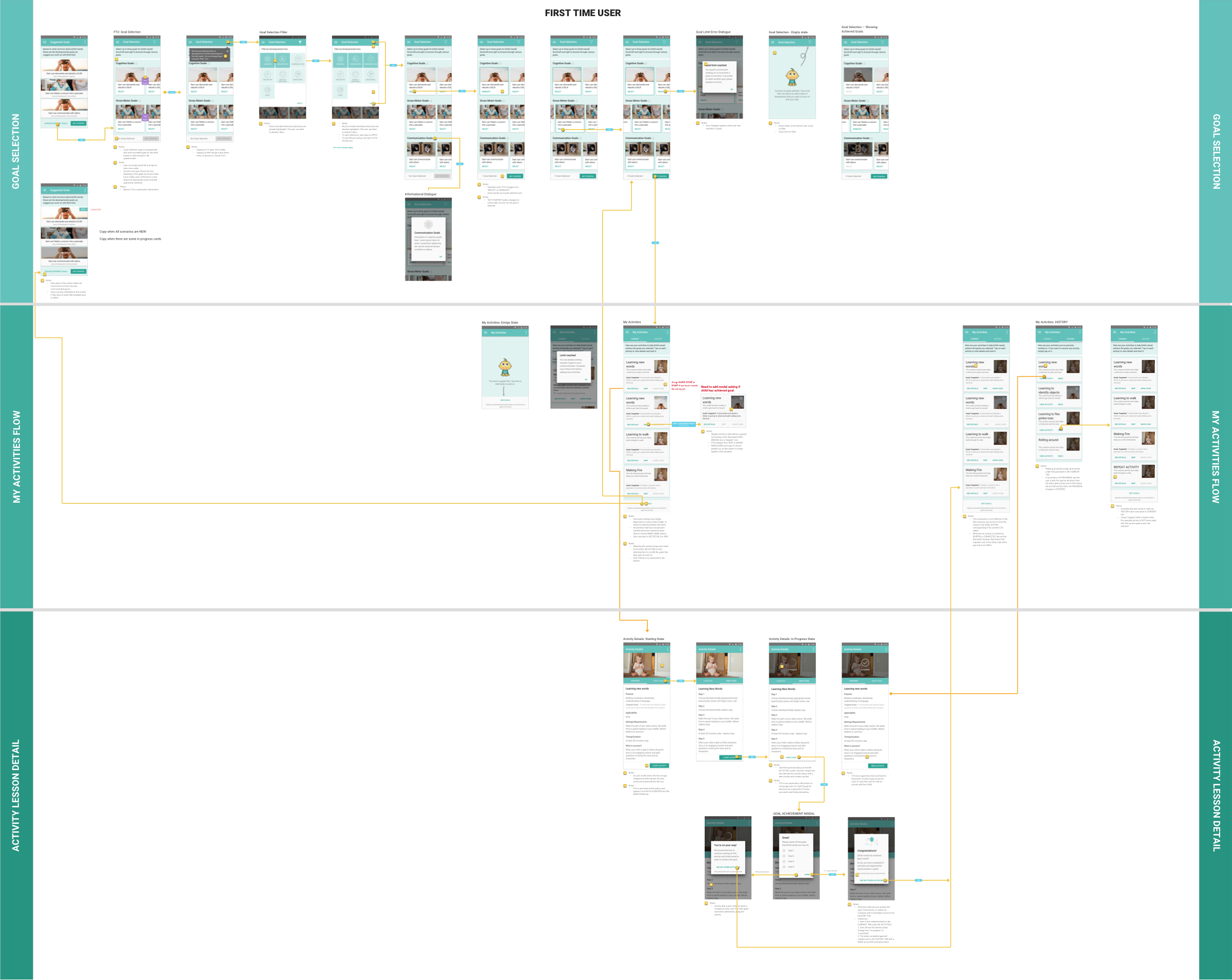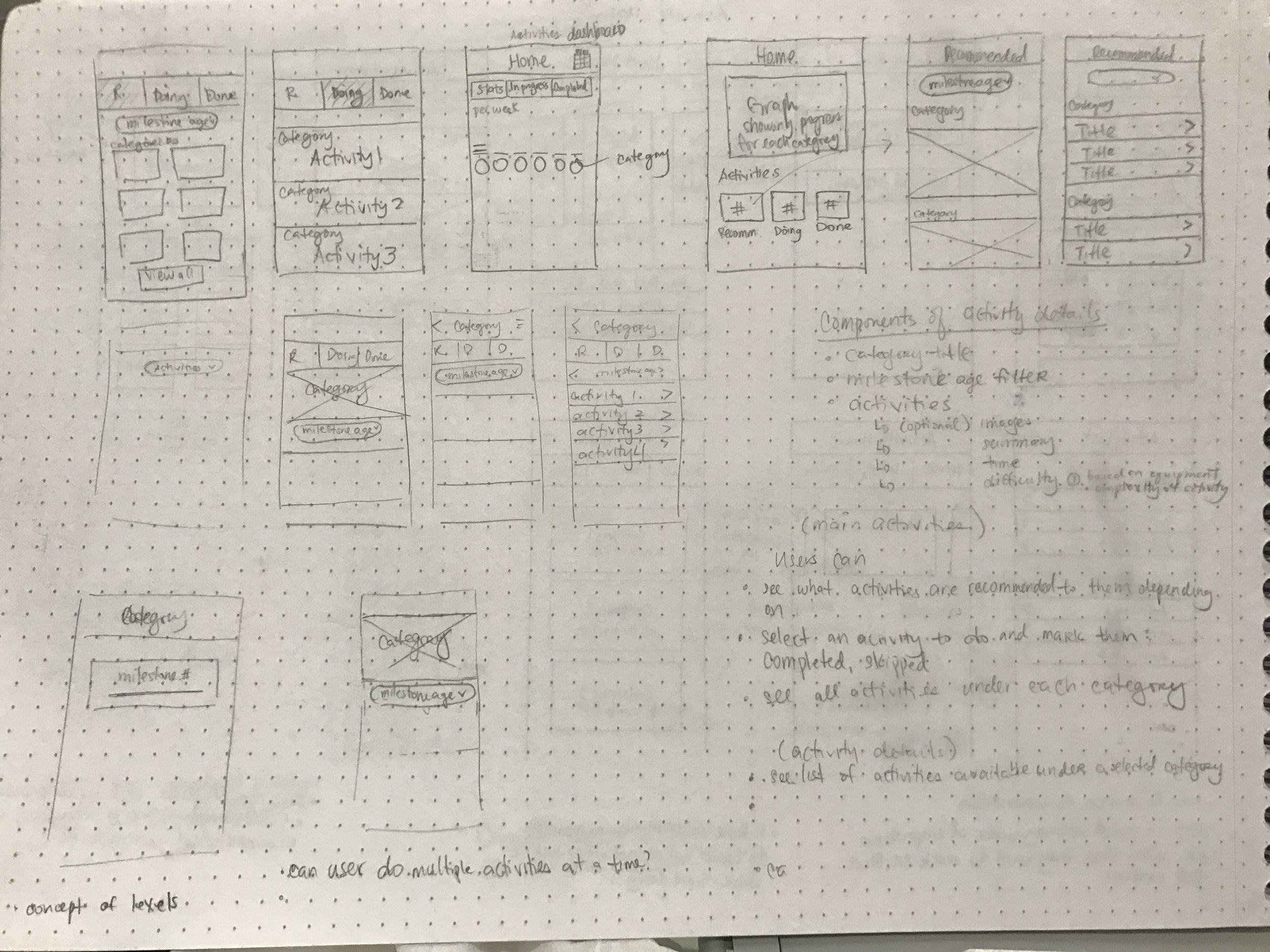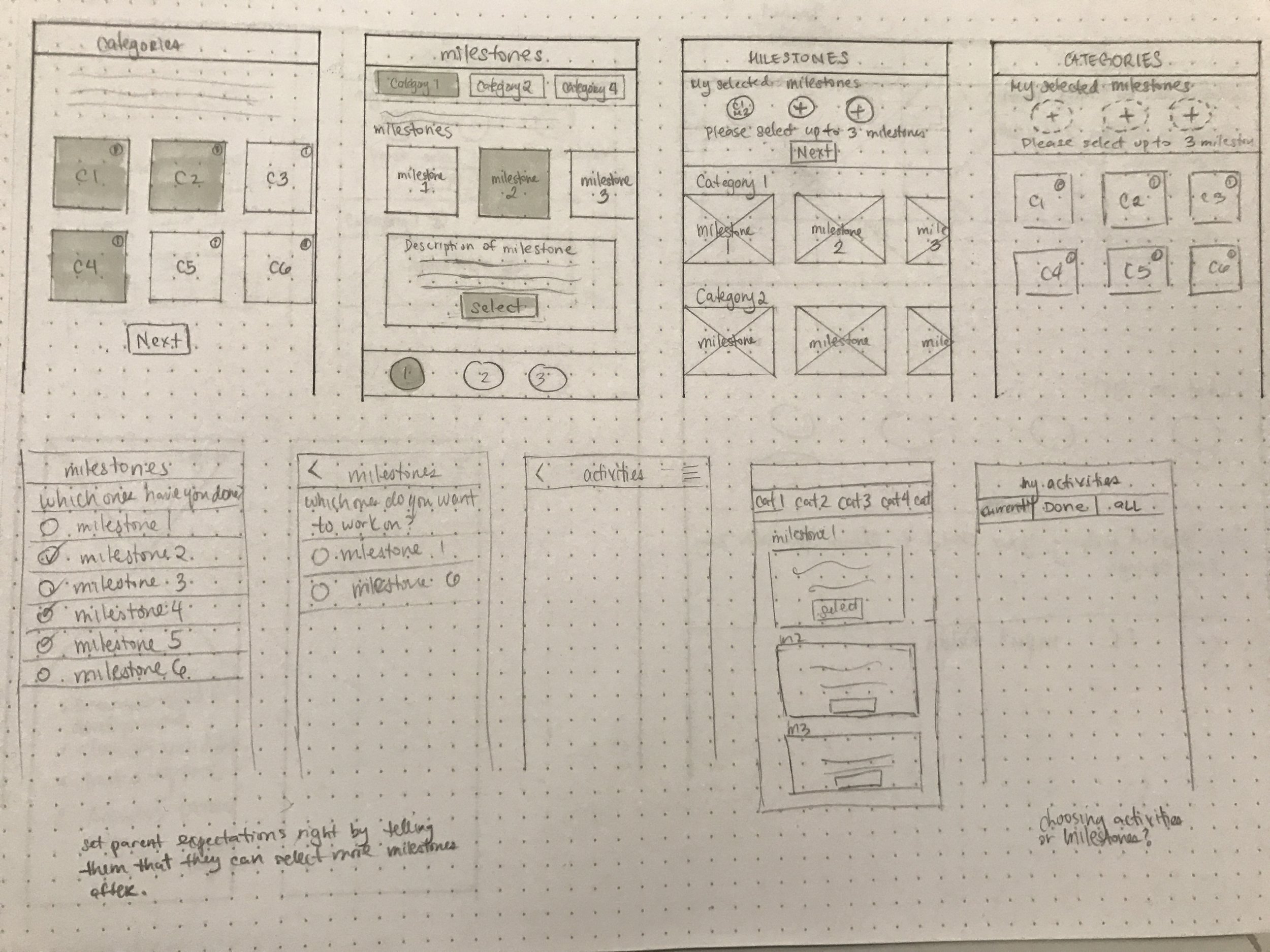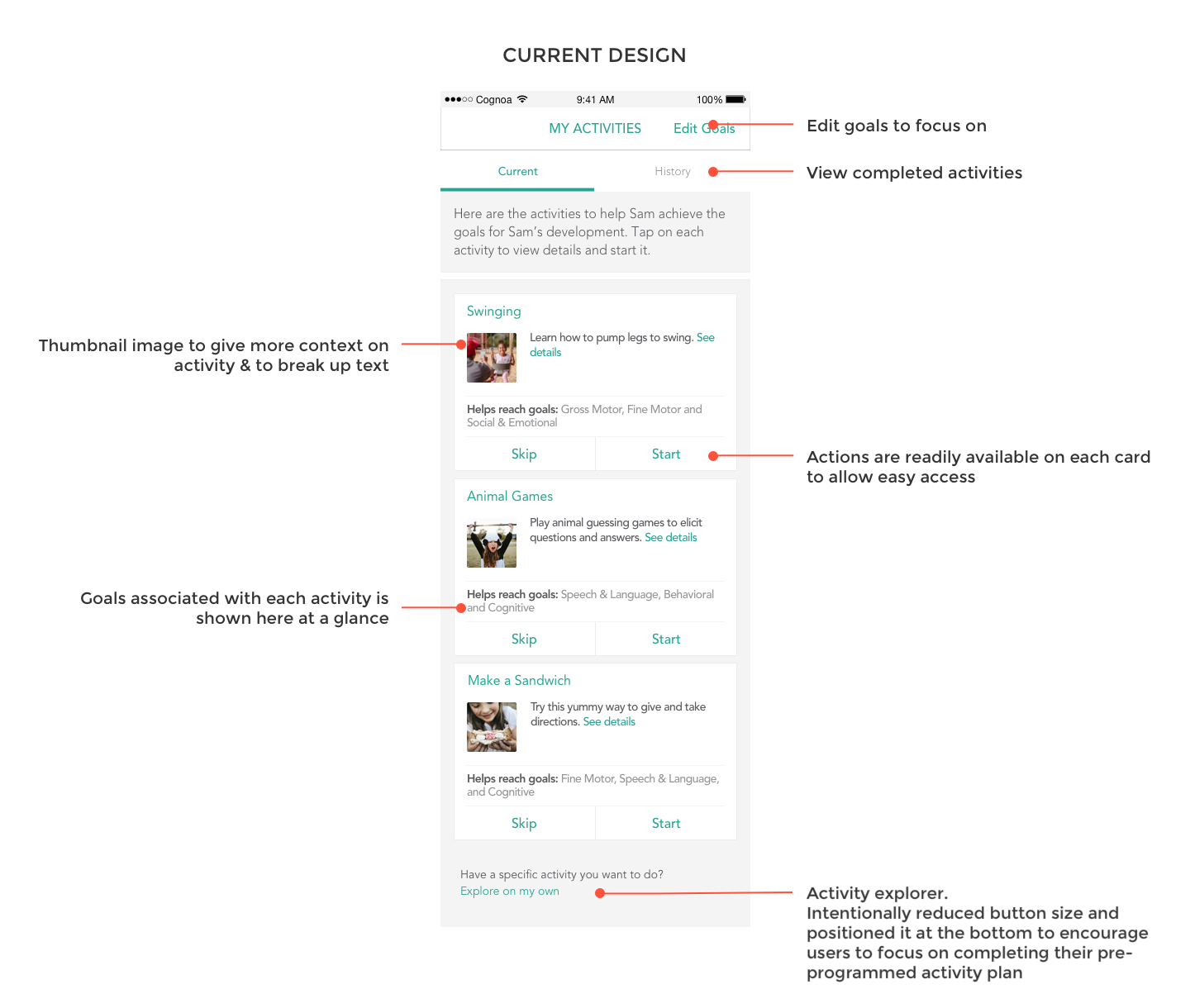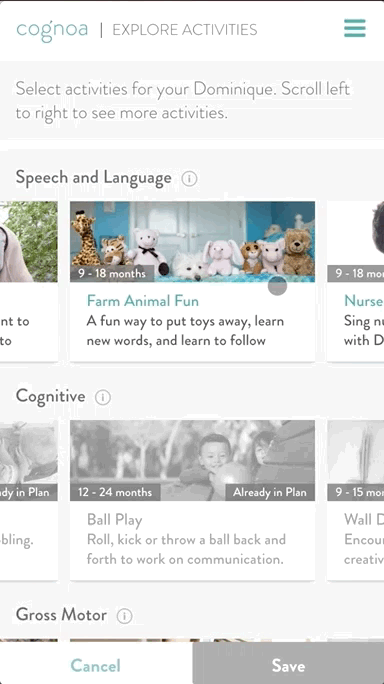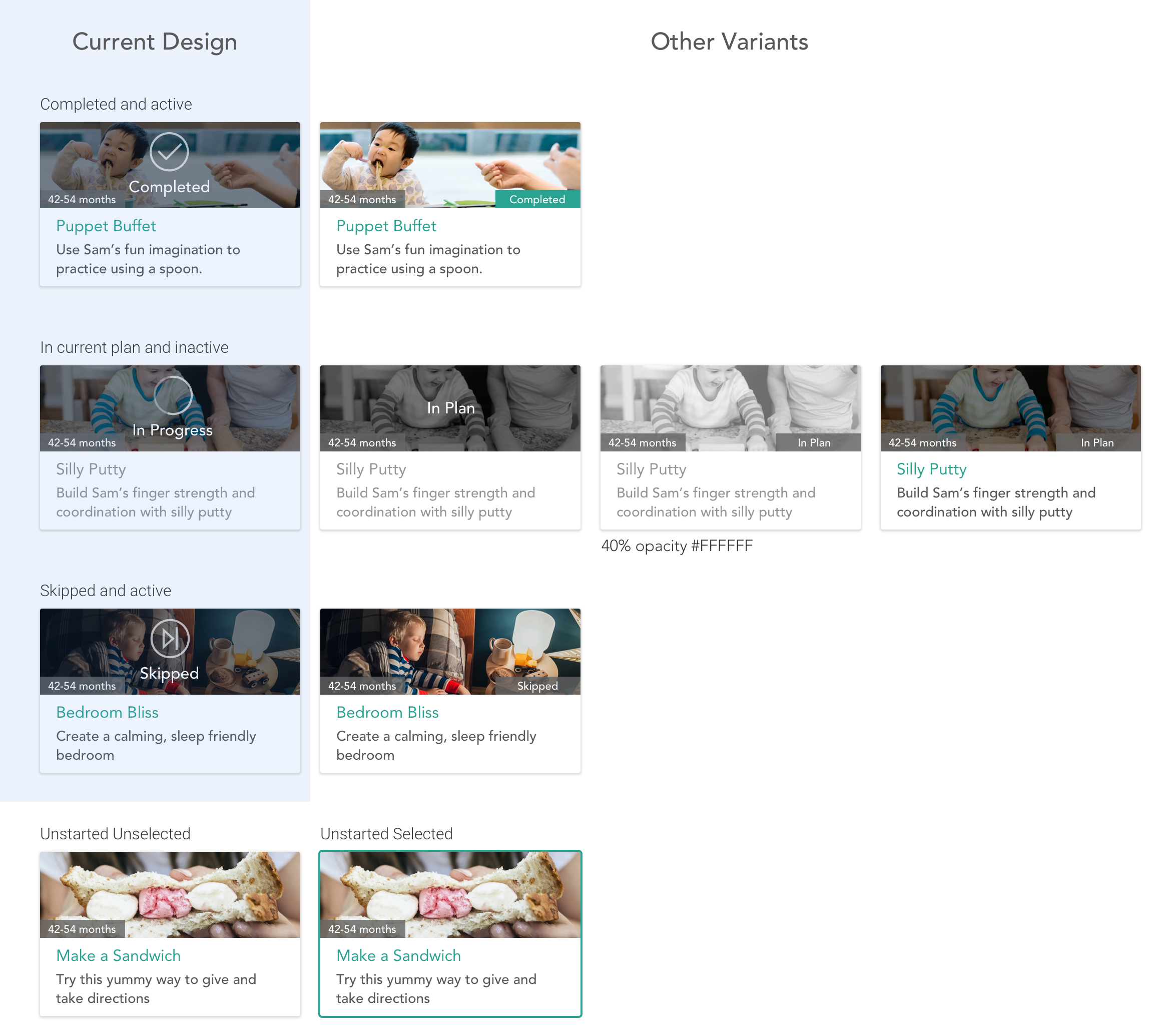Cognoa Activities & Goals
Redesigning a feature to aid parents in helping their children reach developmental milestones
TLDR
Over the span of one year, I led the efforts to redesign one of Cognoa's major features (on iOS, Android and web) to provide parents with a structured plan to help their children reach developmental milestones.
OVERVIEW
Cognoa went through multiple pivots that shaped the vision and direction of our product. As a B2B2C business focused on generating sales from our primary screening app, it was necessary for us to strengthen our main product instead of focusing our efforts on creating several iOS apps. We focused on redesigning the activities feature in our app because it was an area that had the largest user drop-off (over 90%) and therefore the largest potential for generating user value. We closely collaborated with various healthcare providers, our own clinical team and validated our ideas with our users to redesign this feature.
SCOPE
Redesigned one of Cognoa's major features for iOS, Android and Web to provide increased user value and become a step closer into being a full-stack medical device app.
ROLE
I worked closely with a small team of a PM and engineers to redesign this feature. I led the design process for the revamping of this feature, including all user research, wireframing and high-fidelity mocks.
THE CHALLENGE
The main challenge that we faced was to create a unique feature for our parent users that would motivate them to work on daily activities with their child that would ultimately address specific concerns they have about their child's development.
GOAL
We wanted to create a app for parents that would supplement in-person therapy sessions by creating a remote, digital experience that was valuable, easy to understand and results-oriented. From a business standpoint, we wanted to provide users with a valuable service to increase user engagement and retention. Our hope for this activities redesign is to empower them with tools to actively address their child's areas of developmental delays.
TERMINOLOGY
This project delves into detail about child development so here's a few words to take note of:
- Developmental Categories- Area of child development (e.g. Gross Motor, Cognitive, Social & Emotional, Behavioral, etc)
- Development Level- the level that best describes the child's development. Levels have two dimensions: age and developmental category.
For example, each child has an expected Gross Motor skills level for age 12 months, 18 month, etc. The developmental level the child is at is gauged by Milestones - set of goals that assesses whether child can do certain things. If the child can achieve all the Milestones at particular Developmental Level, then child is deemed to have reached the level.
- Milestones- Behaviors and/or physical skills seen in infants/children as they grow and develop. Milestones differ according to each age range and are used to determine whether a child is developmentally on-track by the age these milestones are attained (e.g. crawling, babbling, and maintaining eye contact).
- Activities- In the context of this project, activities are a list of recommended actions that parents can work on with their child to help them achieve the next appropriate developmental level.
- Goals- The result or achievement toward which effort is directed to.
UNDERSTANDING THE PROBLEM
As a first step to redesigning this feature into one that would supplement in-person therapy sessions, I first needed to develop an understanding on what an in-person, hands-on experience was like for parents, their children and medical professionals. We also spoke to numerous medical professionals to understand how they dealt with parental motivation and compliance as that plays the largest factor in seeing success.
Based on this, my team and I were able to parse out various user needs and develop our persona.
MAIN USER PERSONAS
Parents who do not have a high level of concern & child is developmentally on-track
This makes up majority of parents in the population. We want to entice them to continue using the feature by communicating the importance of keeping track of milestones to make sure that their children keeps being on-track for normal childhood development.
Parents who have concerns about child’s development & child is mostly developmentally on-track
We want to give parents a way to easily find and access activities that help address their concerns.
Parents of children who were assessed with severe developmental delays
Our goal for this group is to provide them with guided activities for them to work on while waiting for medical professionals.
FIELD STUDIES & INTERVIEWS
My team and I spent some time visiting medical professionals at their practices to gain better understanding of the current methods employed towards helping children overcome developmental delays.
The time I spent observing therapists, children and their parents in guided settings, and talking with various clinicians allowed me to develop a much clearer understanding of the level of knowledge and effort necessary to create an activity plan for parents to work on with their children at home.
Some notes from my interviews with clinicians
PROCESS
JOB STORIES
Based on my learnings, I created several job stories to uncover various motives our users might have in using our feature (and consequently identify the specific functionalities we wanted our feature to have).
Receive personalized content
“When I am told that I can work on a variety activities to address concerns I have with my child, I want to be shown activities that are personalized for my child so that I can use my time more effectively. ”
Browse database of activities
“When I am using this feature, I want to be able to have the ability to see all of the activities that are available so that I am able to select the ones that I think are more pertinent to my child.”
Get valuable details on each activity
“When I am looking through each activity, I want to be able to see how each of them helps with my child’s development so that I am more able to prioritize which activities to work on first.”
USER FLOW
Before sketching anything, I had to first consider the main flow of the product. This served as the foundation of our feature which I built upon to include increasingly complex interactions, states and permutations.
A basic flow
Eventually, the flow became even more complex as we dug a bit deeper into the feature. Here's a snapshot of a more detailed user and interaction flow for our Android engineer.
Detailed product feature flow for Android devices
USER JOURNEY
I created a simplistic journey map for a first time user in each stage of the new feature. This allowed me to identify opportunities to focus on and address in my designs at each stage.
SKETCHES & WIREFRAMES
One of the prevailing themes of our redesign was to create an 'activity-planner' that gave parents curated activities to work on. My challenge here form a design standpoint was to transform a very information-heavy and hierarchically complex ecosystem into a functional activity plan that was as simple as possible for the user.
I explored these various concepts ranging from high-level questions to more specific ones throughout the design process.
- How might we get our users to understand the value of doing each activity?
- How might we be able to simplify this process for parents so that they can easily work on activities that make the most sense to them while also being able to understand the goals each activity is working towards?
- How might we explore how to group activities given that each activity falls under multiple milestones and milestones fall under various developmental categories which in turn are dependent on the child's age and needs?
- How might we give parents the option to choose what areas to focus on?
- How might we effectively communicate to the user the various states for an activity so that they can easily differentiate which ones are recommended, completed, not yet done, etc.?
Initial brainstorm of concepts and identifying user needs
Various concepts of displaying recommended milestones
Exploring various ways to display activities in a plan
More explorations on how to display multiple activities & how to display detailed information for each activity
DESIGNS
Step 1- Identify and Select Goals
This first step is arguably one of the most pivotal parts of the feature. For us to best set parents and their little ones up for success (ie: seeing positive changes the child's development), it was important for us to be able to help them prioritize working on developmental areas of greater need; otherwise, parents could easily find themselves overwhelmed by sifting through so much information which can consequently hinder meaningful progress.
The most recent iteration of this feature defines a goal to be a developmental category. We found that by focusing their goals to be oriented towards achieving developmental areas instead of attaining specific milestones, parents had less cognitive load and less confusion on the hierarchies involved in crafting an activity plan.
In previous versions of this feature, we defined goals as milestones as we tried to mimic the process that therapists practice in their treatments. However, through user testing, we found that this lower-level approach of identifying and selecting goals to focus on caused a lot of confusion amongst our parent users as they were unable to distinguish the difference between milestones and activities (as they were very similar).
Previous versions of goal selection.
Step 2- Receive Activity Plan
We wanted users to see the various activities that they should be doing with their child in order to help achieve the goals that they have identified in Step 1. There were a number of considerations I had to keep in mind as I was designing this feature. Here are some of them:
- Users can see all the goals they are currently working towards
- Users can, at a glance, see all the recommended activities associated with those current goals
- Users can identify which activities have been started, not started, skipped and completed
- Users can add more activities to the plan
- Users can view a history of activities that were previously recommended to them
ACTIVITY CARDS
In order to effectively showcase the various activities in this content-heavy screen (it can get pretty long), I visually organized each activity by grouping them into individual cards.
I identified the types of high-level content most valuable to our users (through testing) that allowed them to easily discern the value of each activity at a glance.
A summary of main features in the current design of the My Activities screen
ADDING ACTIVITIES
Our initial designs had a very prominent "Add Activities" on this screen. However, we ultimately moved to a more subtle looking button that was below the fold. Our intention here was to set our users up for success by reducing any distractions that would divert their attention away from working on the recommended activities based on their selected goals.
Step 3- View Activity Details
Once a user's interest in an activity is piqued, they can tap into it to view more information about it. The activity detail page is divided into two main parts-- an overview and a directions page.
All of the information in every activity was written by our fantastic clinical team and small group of medical advisors. Like the sleep app (see previous writeup here), we wanted to offer our parent users with information from professionals that was all curated and aggregated in one place.
To address user feedback that some of the instructions were difficult to follow, we added visual images to best reflect the content. We are currently working on adding videos here to further aid parents in getting a good grasp of how to perform these various activities with their child.
Extra Step- Browse Other Activities
One of the pervading themes that we explored is determining the balance between being prescriptive and giving parents the freedom of choice. In order for us to maximize user compliance, it was important for us to make sure that parents have a degree of influence (given that they know their children the best). At the same time, being a professional and trusted service, it was also important for us to be able to guide our users to choosing a plan that was appropriate for their needs.
We ended up with creating a feature that allowed users to modify their activity plan by browsing through a list of activities by categories. I explored different ways to denote the status of an activity and to define what these statuses are.
Snapshot of my explorations with the card design for this feature and the use of icons and colors to indicate states.
NEXT STEPS
This feature is now live in our web and mobile platforms (iOS & Android).
Digitizing an in-person therapeutic experience for young children and their parents on multiple areas of development was an exciting, yet complex journey. We still have a long ways to go to really determine with certainty that this feature can really achieve its goal of being an early intervention tool for childhood development.
Moving forward, we will be spending more time focusing on creating a smoother flow for the process of starting activities, as well as integrating progress tracking functionalities to this feature to allow parents a more convenient way of visually tracking their progress towards achieving various developmental goals.








